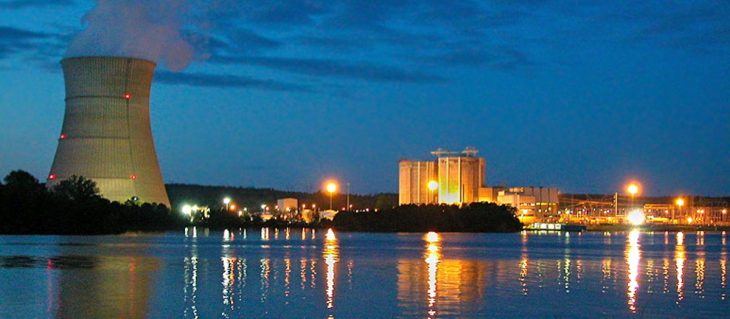DOE launches program to prevent early closure of nuclear power plants
by February 11, 2022 2:51 pm 2,061 views

Entergy's Arkansas Nuclear One power plant in Russellville, Ark. (photo from Entergy)
The U.S. Department of Energy (DOE) has established and is seeking information to implement a $6 billion Civil Nuclear Credit Program, according to a Friday (Feb. 11) news release. The program could lengthen life of service at Arkansas’ only nuclear energy facility.
The program is part of the $1.2 trillion Bipartisan Infrastructure Law and is expected to support the continued operation of U.S. nuclear reactors, the largest source of clean power in the United States.
Arkansas has two nuclear reactors, Arkansas Nuclear One units 1 and 2 near Russellville. They have been operating since 1974 and 1980, respectively, and are owned by Entergy Arkansas, a utility of New Orleans-based Entergy Corp. According to the company’s website, 950 employees work at Unit 1 and Unit 2, and they have a generating capacity of 836 megawatts and 988 megawatts, respectively. The two units generate enough power to meet about 56% of the total energy demand of Entergy Arkansas’ 700,000 customers.
According to the DOE release, the agency is taking the first steps to help avoid premature retirements of nuclear reactors across the country and will preserve thousands of good-paying clean energy jobs while avoiding carbon emissions. The nuclear credit program is expected to support President Joe Biden’s clean energy goals and ensure that communities across the nation continue to see the benefits of sustainable energy infrastructure.
“U.S. nuclear power plants are essential to achieving President Biden’s climate goals, and DOE is committed to keeping carbon-free electricity flowing and preventing premature closures,” said Secretary of Energy Jennifer Granholm. “The Bipartisan Infrastructure Law makes this all possible by allowing us to leverage our existing clean energy infrastructure, strengthen our energy security and protect U.S. jobs. DOE is facilitating the development of next-generation technologies that can ultimately lower emissions and bolster the clean energy workforce.”
Nuclear power provides 52% of U.S. carbon-free electricity, and the existing fleet of 93 reactors is significant to achieve the Biden administration’s goal of reaching net-zero emissions economy-wide by 2050. Shifting energy markets and other economic factors have led to the early closure of 12 U.S. commercial reactors since 2013. The closures have contributed to an increase in carbon emissions in those regions, poorer air quality and the loss of thousands of high-paying jobs, according to the DOE.
The new nuclear credit program will allow owners or operators of commercial U.S. reactors to apply for certification and competitively bid on credits to help support their continued operations. The DOE is seeking input on the structure and executive of the program, including the certification process and eligibility criteria, invitations to submit bids for credits and the allocation of credits. The DOE will take input from all interested parties, including nuclear reactor owners and operators, state and local regulators and officials, tribes, impacted community partners, environmental partners, environmental advocacy groups and others partners involved in clean energy and electric generation, distribution and planning. Responses are due by March 8.
Under the law, applications must prove that the reactor will close for economic reasons and demonstrate that closure will lead to a rise in air pollution. The DOE must determine the U.S. Nuclear Regulatory Commission has reasonable assurance that the reactor will continue to operate safely. Credits will be allocated over four years beginning on the date of selection of reactors that are certified by the DOE.
Also, the DOE will seek applications and provide potential applicants the opportunity to submit voluntary, non-binding expressions of interest in the nuclear credit program.
Link here for more information on the program.
